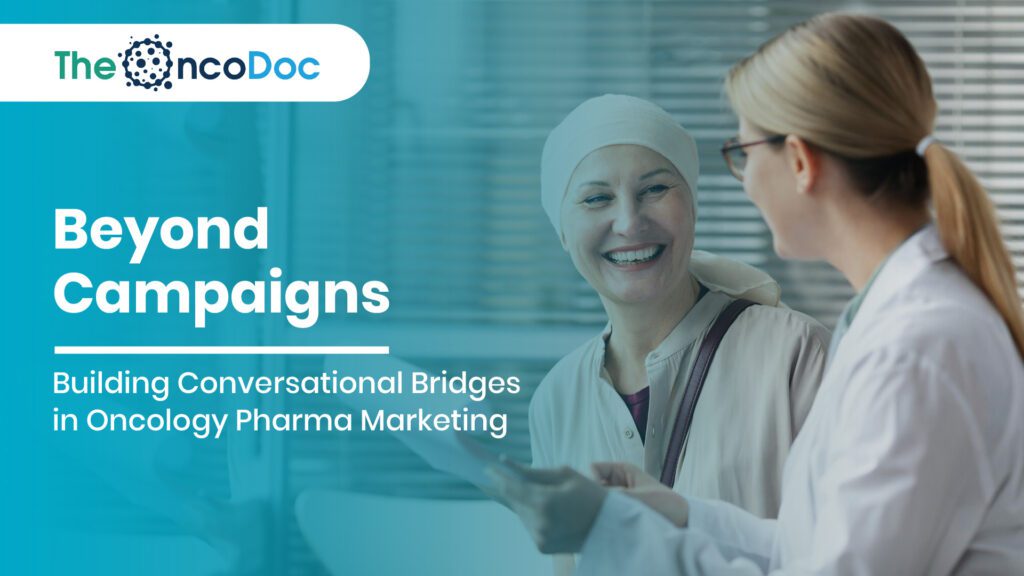Introduction: The Shift from Monologues to Dialogues
Oncology pharma marketing is undergoing a historic transformation. For decades, pharma relied on campaign-driven outreach, structured, one-way messages aimed at physicians and occasionally patients. While these campaigns created awareness, they often lacked the nuance to foster genuine trust in a field as sensitive as cancer.
Today, the paradigm has shifted. Patients, caregivers, oncologists, and general practitioners (GPs) no longer seek polished promotional messages; they seek conversations, open, responsive, and empathetic exchanges that prioritize education, reassurance, and actionable guidance.
This article explores how oncology marketing is moving from campaign-centric pushes to conversation-driven engagement. It unpacks the strategies, technologies, and cultural shifts enabling pharma brands to build trust through two-way communication.
1. From Mass Messaging to Personalized Conversations
Traditional campaigns aimed for reach. But in oncology, relevance outweighs reach. A breast cancer survivor in her 40s, an oncologist treating rare sarcomas, and a rural GP encountering oral cancer symptoms for the first time all require different forms of engagement.
Conversations adapt to context. With AI-enabled insights, pharma brands can:
- Provide tailored digital nudges for at-risk populations.
- Turn on local language-speaking chatbot support in real time.
- Deliver survivor-led community stories that resonate more than brand slogans.
The power of personalized conversations is in meeting stakeholders where they are, not where brands want them to be.
2. Trust as the Currency of Conversations
Cancer affects people emotionally in addition to clinically. When pharma brands talk “at” patients, they risk alienation. When they listen and respond, they build trust.
Trust comes from:
- Transparency (open communication about constraints and negative consequences).
- Empathy (acknowledging patient fears in messaging).
- Consistency (ensuring conversations across channels align).
A trust-driven model redefines oncology marketing: brands shift from being seen as sellers of molecules to partners in health journeys.
3. Engaging General Practitioners as Conversational Allies
GPs are the first gatekeepers of oncology care. Yet, many lack specialized oncology training, often delaying early referrals. Campaign-style CME programs rarely drive engagement. What works instead are interactive, conversational formats:
- WhatsApp-based Q&A sessions with oncologists.
- AI-powered referral chatbots offering diagnostic prompts.
- Case-study podcasts where GPs discuss real referral dilemmas.
This two-way educational approach ensures that GP engagement is not passive consumption, but active participation.
4. Conversations with Patients: Beyond Awareness
Patients diagnosed with cancer are not passive recipients of care, they are active seekers of knowledge. Conversations with them must move beyond awareness slogans to educational dialogues.
Examples include:
- Interactive apps that explain treatment journeys step by step.
- Symptom trackers with conversational prompts that reassure and guide.
- Communities for survivors where patients ask peers questions directly.
Such dialogues reduce anxiety and increase adherence to therapies, far more than one-way awareness posters ever could.
5. Caregivers: The Silent Decision-Makers
In oncology, caregivers often influence treatment choices more than patients themselves. Pharma brands rarely addressed this group in traditional campaigns. Now, caregiver-focused conversations are becoming central:
- WhatsApp reminders for medication adherence.
- AI-driven caregiver portals offering emotional support tools.
- Direct Q&A sessions with nutritionists and psychologists.
Acknowledging caregivers transforms marketing into family-centered engagement rather than patient-only outreach.
6. Emotional Storytelling as Conversational Fuel
Storytelling remains a powerful tool, but its role has evolved. Instead of scripted campaigns, survivor stories now unfold in conversational formats:
- During live Instagram sessions, survivors answer questions in real time.
- Short podcasts where survivors narrate their journey, followed by expert commentary.
- Peer-moderated community chats, fostering two-way empathy.
These authentic narratives drive higher engagement because they are unscripted, relatable, and interactive.
7. Hyperlocal and Vernacular Conversations
Cancer literacy varies drastically across regions. A campaign in English may resonate in Mumbai, but fail in Bihar. Conversations, however, adapt linguistically and culturally.
- Discussions in Tamil are held in local WhatsApp groups in Tamil Nadu.
- In rural Assam, oral cancer awareness is spread through folk storytelling events.
- In Maharashtra, local survivor clubs host village conversations, blending cultural familiarity with medical education.
Mass campaigns cannot guarantee accessibility and confidence; localization does.
8. Digital Health Tools: From Static Apps to Conversational Ecosystems
Apps used to be static repositories of information. Today, they are evolving into interactive conversation hubs.
- Chatbots triage symptoms and provide next steps.
- Oncologist dashboards allow two-way data sharing between patients and doctors.
- Wearable-linked apps start conversations when anomalies are detected.
This integration makes digital health tools less about passive reading and more about continuous dialogues.
9. Metrics of Conversations, Not Campaigns
Campaigns were once measured in impressions and clicks. Conversations demand deeper, health-driven metrics:
- Number of screenings booked via conversational nudges.
- Percentage of patients who ask follow-up questions.
- Emotional sentiment in chat-based engagements.
- Caregiver participation rates in community platforms.
This redefinition ensures pharma evaluates success through impact, not vanity metrics.
10. AI as the Engine of Emotionally Intelligent Conversations
AI has evolved beyond data sorting, it now drives real-time, adaptive oncology dialogues. By processing subtle behavioral signals, AI systems can:
- Determine whether patients are at risk for disengagement and take action before they drop out.
- Guide oncology chatbots to use supportive, empathetic phrasing that builds trust.
· Identify caregiver anxiety by observing patterns of interaction and initiating prompt outreach.
This elevates patient and caregiver experiences from transactional exchanges to human-like, meaningful connections. Every communication feels context-aware, emotionally aligned, and individualized rather than generic. In oncology, where emotions often dictate decision-making, AI ensures that digital touchpoints do not feel cold or mechanical. By combining predictive insight with emotional sensitivity, AI transforms marketing from simple communication into therapeutic engagement, strengthening trust and adherence across the cancer journey.
11. Social Listening: Guarding the Cancer Conversation in Real Time
In oncology, misinformation spreads faster than facts, shaping dangerous patient decisions. Pharma can take preventative measures thanks to AI-driven social listening by:
- Identifying false claims, such as miracle herbal remedies, and countering them with evidence-based oncologist videos.
- Dispel vaccine and screening misconceptions by engaging community influencers and locally trusted voices.
- Analyzing sentiment and tone to ensure responses feel compassionate and reassuring, not confrontational.
This transforms digital monitoring from passive observation into active dialogue management. By engaging communities with accuracy and empathy, pharma brands reposition themselves as reliable allies rather than distant promoters. In a world where online misinformation can delay screenings or derail treatments, social listening ensures the right facts reach the right people at the right time. Ultimately, it elevates pharma’s role to that of a guardian of truth in the cancer care conversation.
12. Survivor Communities: Conversations that Heal
Survivor communities are no longer peripheral, they are at the heart of oncology dialogues. By fostering ongoing discussions:
- Patients find practical answers beyond medical brochures.
- Caregivers gain emotional resilience from shared stories.
- Pharma builds grassroots credibility by enabling, not dominating, these conversations.
These communities are the clearest proof that oncology marketing’s future lies not in polished campaigns, but in authentic, human conversations.
13. The Future: Conversational Ecosystems in Oncology
The oncology marketing playbook of the future will not be about launching isolated campaigns. Instead, it will resemble a living ecosystem of conversations:
- Voice-first technologies answering cancer FAQs in local dialects.
- AR/VR-driven dialogue sessions where oncologists explain therapies visually.
- AI-driven predictive nudges starting conversations before symptoms become diagnoses.
The ultimate goal? To ensure no patient feels alone, no GP feels underprepared, and no caregiver feels unheard.
14. Voice-First Oncology: Breaking Literacy Barriers
In India alone, over 30% of the population has limited literacy skills, a major barrier to understanding oncology awareness campaigns. Voice-first technologies are now bridging this gap by transforming campaign text into conversational audio guidance.
Examples include:
- WhatsApp IVR bots that enable rural patients to call and listen to frequently asked questions about cancer in their native dialect.
- Smart speakers in community centers playing daily cancer prevention tips.
- Voice search optimization ensuring patients find reliable cancer-related answers instead of misleading results.
By breaking literacy barriers, voice-driven conversations ensure inclusivity in oncology awareness.
15. Conversational Nudges for Prevention and Lifestyle Change
Oncology is not just about treatment, it’s also about prevention and early detection. Behavioral science suggests that small conversational nudges can trigger lifestyle shifts that lower cancer risks.
Examples of conversational nudges:
- Daily reminders from apps: “Have you scheduled your screening this month?”
- Friendly chatbot prompts: “Today is World No Tobacco Day, ready to track a smoke-free day?”
- GP-to-patient reminders: short, empathetic texts encouraging routine checkups.
Unlike impersonal campaigns, nudges feel like a personal conversation with a friend or doctor, significantly improving participation in prevention programs.
16. Digital Twin Conversations in Oncology Care
An emerging frontier is the use of digital twins, virtual replicas of patients based on real-world health data. Pharma marketers are beginning to explore digital twin–driven conversations, where patients engage with simulated models of their own health journey.
For instance:
- A patient with breast cancer could see how lifestyle changes (like quitting smoking) alter her twin’s recovery outcomes.
- Oncologists can use digital twins to simulate treatment responses and discuss therapy options in conversational, visual formats.
These personalized, data-driven dialogues build confidence in treatment choices and strengthen patient adherence.
17. Conversational AI for Emotional Well-Being
Cancer treatment involves both medical and psychosocial aspects. Conversations must also address mental health, fear, and resilience. Conversational AI is being trained to provide emotional companionship, helping patients and caregivers cope.
Applications include:
- 24/7 empathetic chatbots offering coping strategies when anxiety peaks at night.
- Conversational apps that integrate meditation, journaling prompts, and survivor encouragement messages.
- Voice-based AI companions in hospital waiting rooms to reduce stress during long oncology appointments.
When conversations acknowledge both clinical and emotional dimensions, oncology marketing evolves into holistic patient support.
18. Pharma as Facilitators of Community Conversations
The most sustainable oncology marketing model is not one where pharma leads every dialogue, but one where they enable communities to converse among themselves.
How pharma facilitates:
- Supporting locally run cancer clubs in rural centers, businesses, and educational institutions.
- Providing survivors with micro-grants to host awareness circles.
- Helpful caregiver organizations that are peer-to-peer and exchange useful advice.
By becoming enablers instead of controllers, pharma companies build trust, positioning themselves as partners in empowerment rather than product promoters.
19. Conversational Market Research: Patients as Insight Partners
Instead of relying solely on clinical trial data or post-market surveys, pharma brands are beginning to use conversational platforms for real-time market research. Patients and caregivers can provide:
- Live feedback on treatment side effects via chatbots.
- Short voice-note testimonials about their experience with oncology care.
- Voting-style polls on preferred support services (nutrition, counseling, transport aid).
This approach makes patients co-creators of oncology solutions, rather than passive data points, while giving pharma real-world insights faster than traditional research cycles.
20. Micro-Influencer Conversations in Oncology
Large celebrity endorsements often lack credibility in oncology. Instead, micro-influencers, local oncologists, community nurses, survivor advocates, are driving more authentic conversations. Their strengths lie in:
- Grassroots trust, they are known in their local communities.
- Cultural relatability, speaking in dialects and lived experiences.
- High engagement, their smaller, niche audiences interact more meaningfully.
Pharma brands collaborating with micro-influencers enable trusted community-driven dialogues that mass campaigns cannot replicate.
21. Conversational Compliance and Ethics
In oncology, compliance is as critical as compassion. Conversational marketing must ensure:
- Ethical dialogue boundaries (avoiding medical claims beyond evidence).
- Data privacy safeguards when patients share sensitive health details.
- Regulatory-approved conversational templates for digital assistants.
Pharma builds long-term confidence by upholding ethical norms, which guarantee that discussions are safe, legal, and credible.
Conclusion: Conversations as the Core of Future Oncology
Oncology marketing has transitioned from one-way campaigns into a living, breathing network of conversations. Each conversation, whether between patient and chatbot, GP and oncologist, or caregiver and survivor, carries the potential to save lives through earlier detection, better adherence, and stronger resilience.
The future of oncology pharma marketing will be defined not by the size of a campaign budget, but by the depth, empathy, and inclusivity of its conversations. The brands that thrive will be those that:
- Listen more than they broadcast.
- Empower communities instead of controlling them.
- Blend technology with humanity to deliver both data-driven precision and emotional support.
In cancer care, where every dialogue could influence survival outcomes, the message is clear: Conversations are not just marketing, they are medicine.
The Oncodoc team is a group of passionate healthcare and marketing professionals dedicated to delivering accurate, engaging, and impactful content. With expertise across medical research, digital strategy, and clinical communication, the team focuses on empowering healthcare professionals and patients alike. Through evidence-based insights and innovative storytelling, Hidoc aims to bridge the gap between medicine and digital engagement, promoting wellness and informed decision-making.



